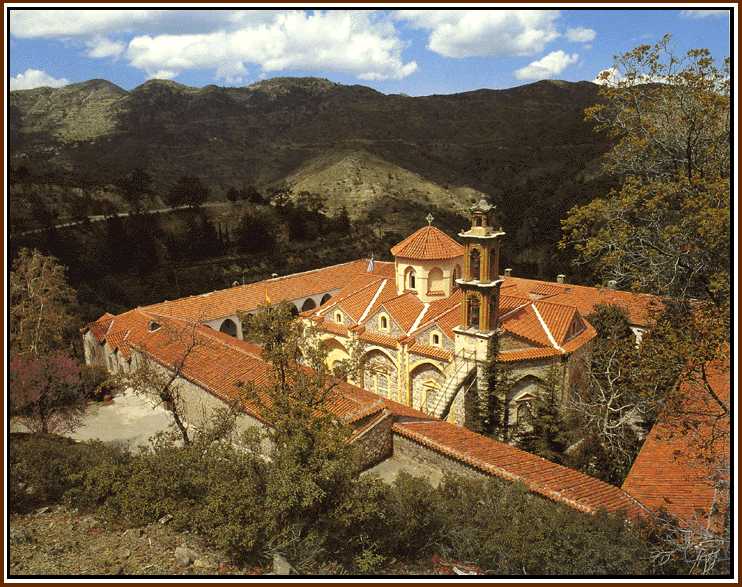
View of the monastery
|
In the mountain forests of Machairas belonging to the Nicosia district there is a monastery dedicated to the Virgin Mary . It is called 'Machairotissa' after a famous icon kept there . It lies at about 870 metres above sea level close to the village of Lazanias and was founded at the end of the 12th. century . Its history begins with an unknown hermit . In the time of the iconoclastic dispute in Byzantium , he brought one of the 70 icons , which are said to have been painted by the Apostle Luke , secretly from Asia Minor to Cyprus . After his death , the icon of the virgin remained in its hiding place until the arrival of two other hermits from Palestine in 1145 : Neophytos and Ignatios . According to tradition , the two monks found the icon in a cave . In order to reach it , they needed a knife (Greek 'machairi') so that they could cut away the undergrowth around the cave . It was given to them by ' divine hand ' . Accordingly , the icon of the Virgin Mary was called "Machairotissa " (and later also the monastery) . After the death of Neophytos , Ignatios travelled with another monk , Prokopios , to Constantinople before the year 1172 where they succeeded in obtaining financial assistance from the Byzantine emperor Manuel Komnenos . Back in Cyprus , they constructed a small church which was enlarged by the monk Neilos in the early 13th. century . He became the first abbot , later rising to become bishop of Tamasos . The Angeloi emperors Isaac and Alexios granted the monastery new privileges at Neilos's request : it was dispensed from tax payments . The abbot drafted the first rules which have applied since then for the monastic community . He was followed by Ioakeim , later Ioannes and Konon took his place . They came from Asia Minor to support the Orthodox in the struggle against the Latin intruders in the period of Lusignan rule . Leontios , a monk from Machairas and author of the comprehensive work 'Exegesis of the enchanting land of Cyprus' , has left us written documents on the monastery and Frankish rule on Cyprus in the 14th. century . According to an inscription on a stone slab , the monastery burned down completely in 1530 . Just as in Kykkos , only the icon of the Virgin Mary survived this fire . Kleopas , a monk and calligrapher , makes mention of donations at the beginning of the 17th. century . In 1697 , during the period of office of Abbot Leontios II , the church was renovated . 23 years later , a monk of Arab origin , Parthenios , was elected abbot . He had come to Cyprus as a child and continued with the reconstruction of Machairas . Abbot Ioannikos (1766-1796) formed close spiritual , intellectual and economic links with Moldavia and Wallachia . The Russian monk Basil Grigorovich Barsky visited the monastery in 1735 , noting in his diary : ' Machairas is one of the largest and most famous monasteries in Cyprus that belongs to the jurisdiction of the archbishop . Located like Kykkos on uneven ground , on the tops of the mountains , above a ravine . The monastery is rectangular in layout and covered with a tiled timber roof . In addition , it has two entrances , one of which is the main entrance facing towards the east , the second looks to the west . The main aisle of the church has wonderful propylaea with columns on the western side . It is covered by a dome and the large tiled roof which extends over the whole church . Inside the church are icons , chandeliers , stone floors and frescoes . There are only 25 monks ; they are extremely active and modest . They live mainly from agriculture and the donations of Christians . |